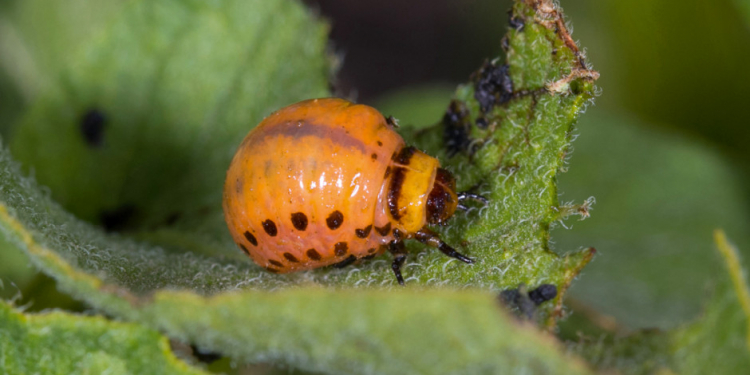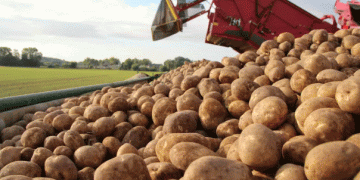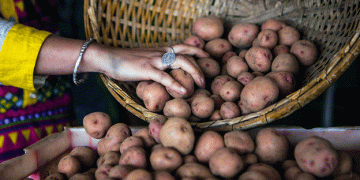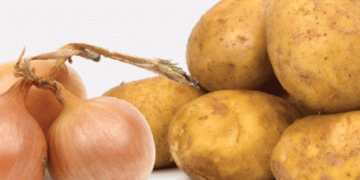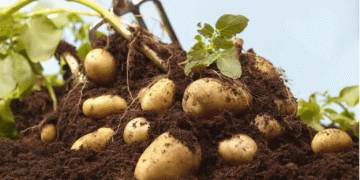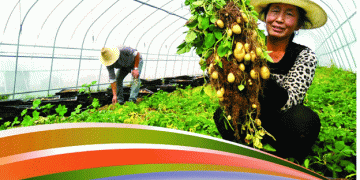The problem of the resistance of the Colorado beetle to the active substances of insecticides of various chemical groups, the palette of which gradually shrinks, makes it difficult to fight this pest.
Among the pests that feed on the aerial parts of the potato, the Colorado potato beetle remains the most important. Both the beetles and the larvae of this insect can quickly lead to complete stagnation of plants in inadequately protected plantations. After hibernating in the soil, Colorado beetles become the most active when the soil temperature rises to approx. 15 ° C. However, it is difficult to precisely determine the exact date of its appearance on the plantation, because it can be very long, and it is mainly determined by weather conditions. A similar situation also applies to the date of laying eggs, which one female can lay even several hundred on the underside of potato leaves during her life (in drought conditions, reproduction is limited).
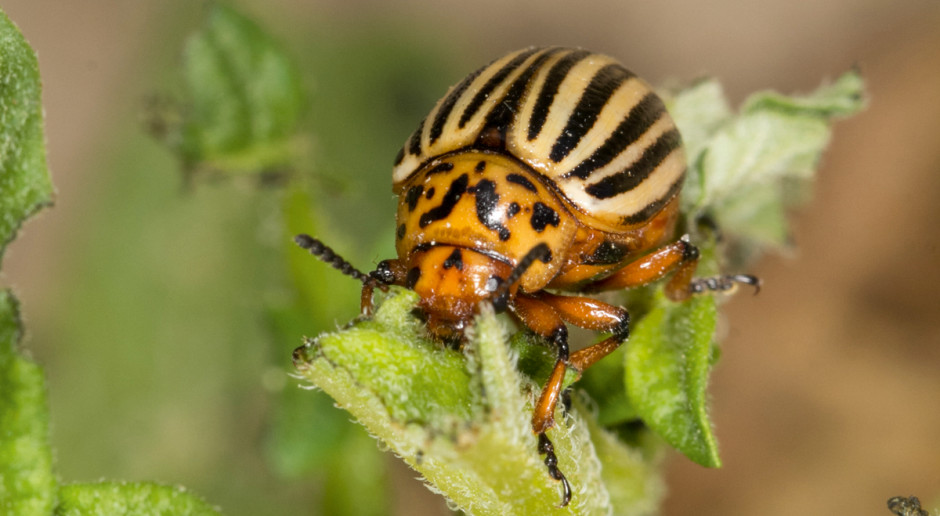
Mainly the larvae are harmful
In spring, the Colorado potato beetles initially feed on the edge plants closest to the wintering site. However, the voracious Colorado beetle larvae cause the greatest losses, especially in early and mid-early varieties. Compared to beetles, the larvae cause over 70 percent. damage. After hatching from the eggs, they immediately start feeding, initially gnawing small holes in the leaves and then destroying them completely. Particularly voracious are the older larval stages, which, after stripping the leaves of the plant, gnaw on the side shoots and stems, and subsequently may also damage the tubers. They go through 4 development stages and then pupate in the soil. Limited assimilation as a result of significant pig-eaters makes it difficult for potato plants to develop good-quality tubers in an appropriate number.
When to combat the Colorado beetle?
The main term for the control of the Colorado potato beetle is the period when most of the larvae on the plantation are in the L2-L3 stages. The decision to apply the control treatment must result from the actual threat to the plantation and after exceeding the harmfulness thresholds determined on the basis of systematic monitoring, which are 10 egg deposits per 10 plants or 15 larvae per 1 plant.
The effectiveness of chemical pest control depends primarily on the precisely determined date of the treatment, the applied insecticide in the appropriate dose and at the optimal temperature of its operation. The insecticides currently registered for the control of the Colorado potato beetle are presented in the table. While controlling the Colorado beetle, other pests that may feed on potato plants during the same period, such as aphids, will also be potentially limited. The higher of the recommended doses can be used for lush leaves and for the control of beetles and older larval stages when they are more severe.
To protect the potato against the Colorado potato beetle, a biopreparation containing Bacillus thuringiensis bacteria can also be used, which should be applied earlier, because it fights the Colorado beetle larvae at the L1 and L2 stage. Compared to conventional protection, biological methods without additional subsidies are currently more expensive, but from the point of view of integrated protection, they are beneficial and future-proof.
Resistance confirmed in numerous studies
Currently, with the introduction of new European Commission strategies, more active substances are withdrawn from use than new ones are introduced. The lower availability of various insecticides reduces the effectiveness of control, incl. due to the increase in resistance of the discussed pest, which is a natural and common phenomenon occurring in insects and other pests.
he history of chemical control of the Colorado potato beetle shows that even the constant introduction of new active substances from various chemical groups did not solve the problem – this pest developed resistance to most of the active substances used over time. In addition to the strong selection pressure caused by insecticides the rapid development of resistance in the Colorado potato beetle was influenced by the biological and behavioral features developed by this species. The Colorado potato beetle is very adaptable to changing environmental conditions.
As an oligophagous species as a result of co-evolution with poisonous plants of the nightshade family (Solanaceae), containing harmful alkaloids, terpenes and phenols, this pest has developed a strong natural resistance, mainly based on enzymatic mechanisms, which it now uses to detoxify chemical and biological substances used in protection potato crops. Global warming is a factor that may indirectly increase the risk of growing resistance of the Colorado potato beetle. Under the conditions of the Polish climate, the full development cycle of the Colorado potato beetle lasted on average 38-40 days.
As a result of the changes taking place before our eyes, this cycle was shortened. Currently, under favorable conditions for the Colorado potato beetle, it can last for 34 days. This allows for the development of two generations of the pest in one growing season. A greater number of generations during the growing season creates a greater possibility of accumulating resistance genes.
Currently, the resistance of the Colorado potato beetle to active substances of insecticides from various chemical groups is still a big problem in the effective protection of potatoes. This is confirmed by research conducted at the Institute of Plant Protection – National Research Institute, which in recent years has shown cases of resistance of this pest population to deltamethrin, lambda-cyhalothrin (pyrethroids) and chlarantraniliprol (diamides). Only with regard to two active substances: phosmet (organophosphorus compounds) and acetamiprid (neonicotinoids), the Colorado potato beetle showed high sensitivity.
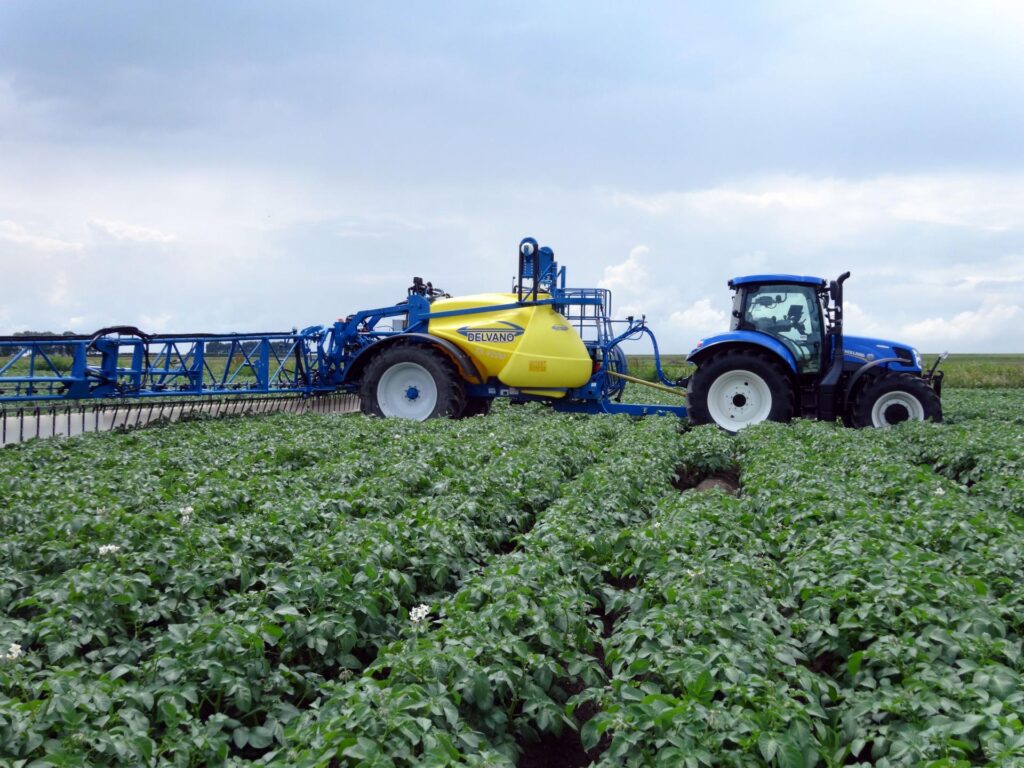
The basic measures to prevent the effects of resistance include constant monitoring of the levels of sensitivity of this pest to the active substances of insecticides.. The rotation of active substances with different mechanisms of action also plays an important role. According to these recommendations, a given active ingredient with a specific mechanism of action should only be used once per season.
In addition, the use of biological methods, as well as correctly performed agrotechnical treatments and compliance with the recommendations of integrated pest management reduce the number of the pest, and thus minimize the need for chemical protection. In this way, they contribute to the reduction of selection pressure and reduce the rate of growth of immunity.
